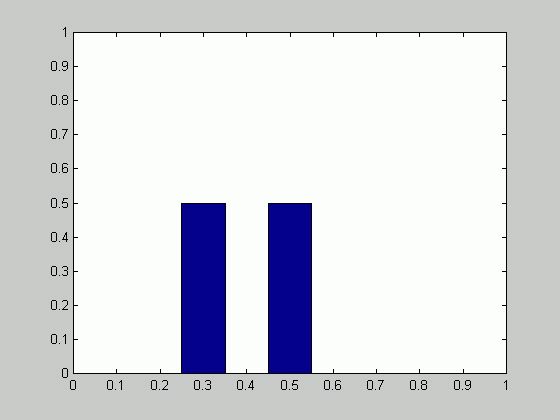
Let's recall that in order to compute the a posteriori probability P(w|x), the class-conditional densities p(x|w) are to be estimated for each class. Suppose that in order to perform estimation, we are given a set of samples X consisting of the subsets X1, X2, ..,Xc, where c is the number of classes and the samples of Xk belong to class wk. Consider the class-conditional density function of a class wk given the set of samples p(x|wk, X ). It is quite obvious that only the samples drawn from the same class, i.e. the subset Xk may influence the value of the above-mentioned probability. Therefore, p(x|wk, X )=p(x|wk, Xk ).
Furthermore, we can now reduce the class notation because all the samples used in the formula are drawn from the same class. In other words, we have just reduced our problem of estimating the class-conditional densities to the problem of estimating an unknown density function p(x) from which the set of samples X is drawn.

In the figure above, the samples are drawn from two classes, w1 and w2. We are dealing with the supervised case, that is the state of nature (class label) for each sample is known. Therefore, we can divide the set of samples according to the class they belong to, and solve the problem of estimating the class-conditional densities separately for each class.
Currently our problem is reduced to computing the estimate p(x|X) of the probability density function p(x).
As we already mentioned in the introduction
section, the approach presented here assumes that the form of the probability
density p(x) is known while the distribution parameters are those needed
to be estimated. In other words, given a vector of parameters ![]() , the
function p(x|
, the
function p(x|![]() ) is completely known. In case of normal
distribution
) is completely known. In case of normal
distribution ![]() is composed of the mean vector and the covariance matrix elements.
Another assumption we make is that the a priori distribution of the parameters
p(
is composed of the mean vector and the covariance matrix elements.
Another assumption we make is that the a priori distribution of the parameters
p( ![]() ) is known.
) is known.
Let's now see how p(x|X) can be computed.
![]()
As was mentioned above, the density function
p(x| ![]() ) is known. In order to find p(
) is known. In order to find p( ![]() | X)
we can apply Bayes rule.
| X)
we can apply Bayes rule.

We stated earlier that the distribution of
parameters p( ![]() ) is known. If we make another assumption
that the samples are drawn independently, then the p( X|
) is known. If we make another assumption
that the samples are drawn independently, then the p( X|![]() )
term can be decomposed as follows:
)
term can be decomposed as follows:
![]()
Using the formulas above, the cross-conditional density functions p(x|wk) can be obtained for every class wk. In the sections that follow we'll take a detailed look at the case where these density functions are assumed to have normal distribution. Below we'll look at a simple though impractical example illustrating the formulas.
Suppose we have two coins. They look the same, but we know that one of them is fair (P(head)=0.5) while the second is not (P(head)=0.3). A coin is picked randomly (with probability 0.5 ) and tossed 100 times. 40 heads occurred. What is the probability of obtaining a head if the picked coin is tossed?
Let's now try to formulate the problem in terms of the notations we developed earlier.
Obviously, the only parameter here is the probability of obtaining head.
![]()

X is the set of samples. Let's assume that the order of the samples is known as well as the number of heads. For instance,
![]()
Therefore, it holds that
![]()
Then,
![]()
From the formulas
above p( ![]() | X )
can be easily
obtained:
| X )
can be easily
obtained:


Finally,
![]()
which answers the question of what is the probability of obtaining head given the samples.
Click here to play with an applet demonstrating the example above.